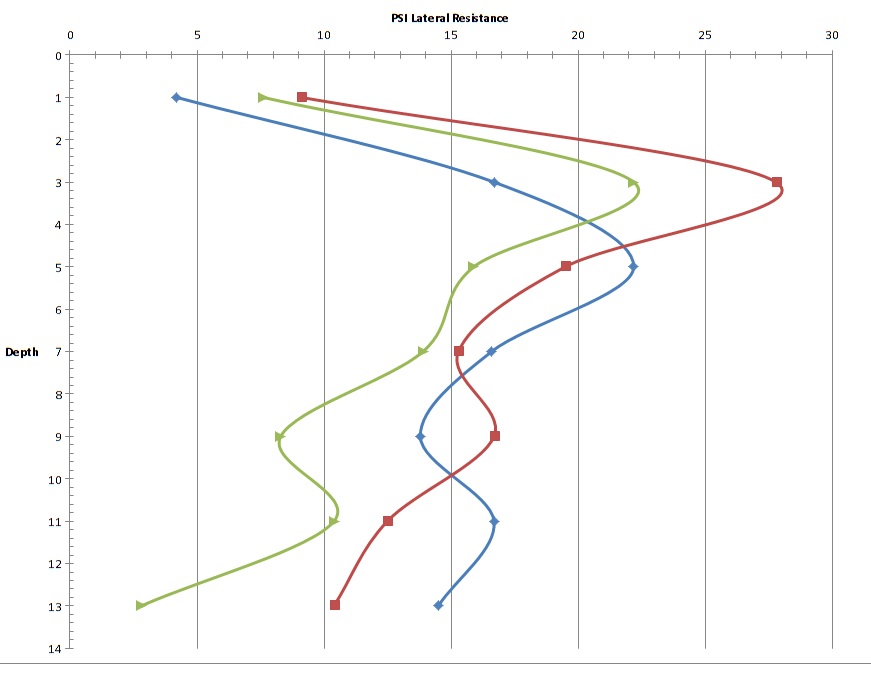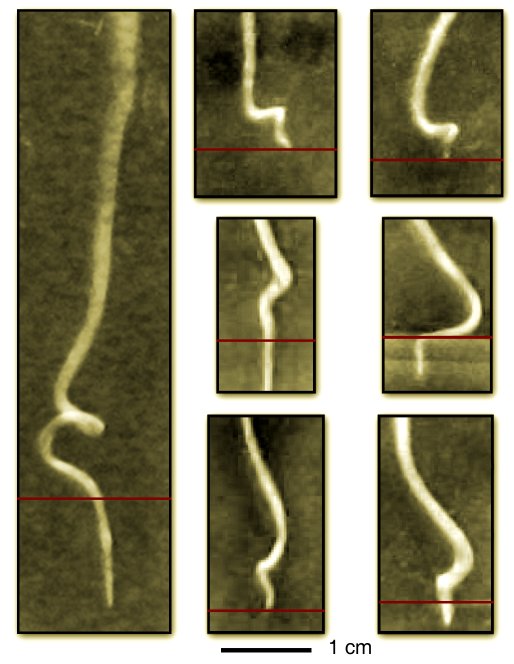In my last article I posted (9/23/19) regarding what can happen even in moist soils like what happened this spring of 2019 – I shared data of soil resistance from the perspective of vertical and horizontal compaction in silt loam and silty clay loam soils.
With today’s segment of the large amount of data I will draw your attention to sampled sites of sandy loam soils (approx. 14% clay, 68% sand and the remaining 18% silt). I was allowed to look and dig in conditions that are normally plowed with a moldboard plow and 4 operations after the pass of the plow, overhead sprinkler strip-till systems approach and then strip-till furrow irrigated. This ground has been farmed since the early 1900’s by the same family and irrigated. In the last ten years they switched to part of the entire farm to strip-till for their corn acres. The family has grown corn, malting barley, sugar beets, and bulk onions as their rotation for more than 30 years.
Fig. 1 Strip-Till beneath overhead center pivot sprinklers. Crop is corn. Has been strip tilled now for 6 years.
First chart of Strip-Till under Pivot Irrigation
The soils when I sampled back in the first days of June were very moist after the frequent spring rains which were wonderful except for getting crops planted when the calendar seemed to point to NOW! Take a look at the first graphic of depicting vertical compaction in the row where the current crop resides, the guess row and then the wheel row. The grower strip tills with an 8 row-30 inch Orthman 1tRIPr at 8-9 inch depth and then plants with a 12 row planter all operations done with RTK-GPS guidance. My positioning of where I sampled for the guess row (see the blue line in the graph to your left) got in the row where the wheels of the planter rode. The green line depicts the amount of down-force the grower applied with his planter. The red line exhibits what occurred in the wheel row which I did find quite easily. Just below the depth the shank and point ran vertical compaction jumps up to 300+ pounds per square inch (psi). This soil is low in soil organic matter but the grower informed me that they have risen in the last 6 years with the advent of his using strip-till to right at 1.5% from under 1.0%. They do not graze stalks overwinter.
Second chart of Strip-Till surface furrow irrigation
In this chart the grower still follows the previous years row on a shallow bed and strip-tills corn. The lay of the ground is very flat. As in Figure 1, this chart Figure 2. to your left; red line is the wheel row, blue line is the guess row and green line is in-crop row where corn is growing. The curved line in red depicts that lateral compaction rises to 27 psi then falls off with depth with a small rise at 9 inches as where the depth of the strip-till shank and point was set during the spring strip till operation. With the green line where the corn was planted at 3 inch depth there is some lateral resistance to a point of 22 psi. As stated in the previous blog article last wrote (9/22), root growth at the tip is negatively influenced above the 60 psi range from extending in the soil medium. So we are seeing any problem due to impedance. As I was digging, probing and looking the roots, above the 6 inch depth, were not kinked, blunted or swollen at the tip as the seedling roots were growing out and down at the normal 25 degrees of the soil surface.
It is concerning that these soils become hard with drying below that 6 inch depth and a strong 20X hand lens I saw a blunting, helical and twisted appearance to the root tip and back some 25mm ( 1 inch). For me I am now curious as a cat. I got back to my office and looked into my quiver of research papers from Plant Physiology regarding root growth. Colombi et al. wrote a striking paper in 2017 about shape of roots that encounter increased soil strength (compacted soils). The premise of their efforts in crops early development that roots have differing shapes some being more elliptical, thickening and larger intercellular spaces behind the root tips. Researchers at Penn State in 2013 corroborate these kind of findings in corn. Postma and Lynch, 2011 & 2013 published findings that support this for us to understand how a corn plant deals with physical stresses of water, low nutrient availability and soil impedance.
Fig. 2: Lateral view of compaction in Pivot irrigated field with Strip-Till.
What am I saying here? When roots attempt to grow in and through more dense, compacted soils they are able to develop cellular structures that have stronger cell walls and larger cavities to hold air behind the root tip to aid in forcing the root deeper and further into the soil. Anne Ju at Cornell University suggests that roots will form helices to then like a spring force the root tip to push off and extend further when the environment of the soil (Cornell Chronicle, Sept. 2012). Some scientists call this a root buckling effect. When the spring release the root pushed forward and through. See the images directly below and to the left..
Also some other Cornell University scientists have revealed with micrographs that very fine root hairs will extend right behind this coil-like structure to anchor the root and the spring-like action is even stronger to push the root forward. Wow! There is a point where the root in it’s abilility to overcome soil resistance is around 2MPa or about 300 psi and root tip growth may cease all together. This was observed with Barrelclover in a lab.
This material I read in the Itai Cohen Groups website, cohengroup.lassp.cornell.edu authored by, Silverberg, et al.
Concluding Remarks:
Whether we are observing corn, wheat, Barrelclover from the Mediterranean area, peas, soybeans or barley – plant roots exert a certain amount of push force to grow down and out from the plant into the soil to gain water and nutrients for growth and maintaining life until senescence. Our purpose to carry out these early soil resistance studies to offer what is happening with three common tillage systems of the corn growing regions we at Orthman work in.
In this article I wanted to give you an indication of what we observed in irrigated sandy loam soils. In the fields where I was looking (sandy loam soils) the roots had not extended down below the 9 inch depth. The penetrometer encountered pressures of 200 to over 300 psi of resistance. In the next rendition I will compare the resistance values we observed in sandy loam soils that were furrow irrigated with strip till and with the moldboard plow tillage systems approach. Some striking differences. Until then….
Cornell Univ. images of twisting of roots in response to longitudinal forces of soil resistance.
References of research:
Root tip shape governs root elongation under increased soil strength, Colombi et al., 2017, Plant Physiology, Vol 174, pp. 2289-2301
Root cortical aerenchyma enhances growth of Zea mays on soils with suboptimal availability of Nitrogen, Phosphorus and Potassium., Postma J. and Lynch, J.P., 2011, Plant Physiology, pp. 1104-1111
Theoretical evidence of the functional benefit of root cortical aerenchyma in soils with low phosphorus availability. Postma,J and Lynch, J.P. 2010, Annals of Botany, Vol 107, pp.829-841
3D Imaging and mechanical modeling of helical buckling in Medicago trunccatula plant roots. Silberberg, J. et al., 2012, Proceedings of the National Academy of Sciences, Vol 109(42) pp.16794-16799

